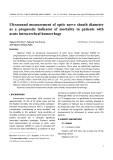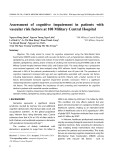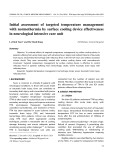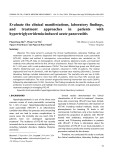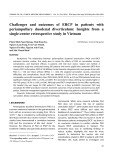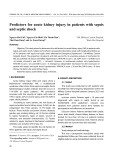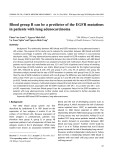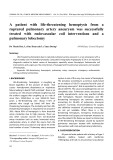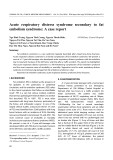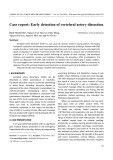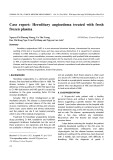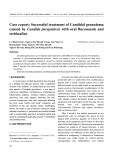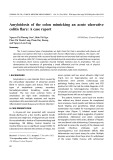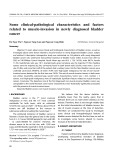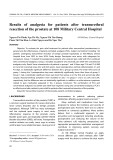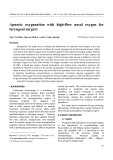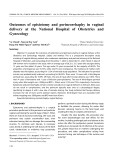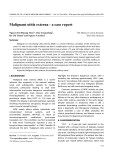
HUE JOURNAL OF MEDICINE AND PHARMACY ISSN 3030-4318; eISSN: 3030-4326HUE JOURNAL OF MEDICINE AND PHARMACY ISSN 3030-4318; eISSN: 3030-4326
156 157
Hue Journal of Medicine and Pharmacy, Volume 15, No.2/2025 Hue Journal of Medicine and Pharmacy, Volume 15, No.2/2025
Assessing medical professionalism among students at Hue University of
Medicine and Pharmacy in 2023: A multi-method evaluation approach
Nguyen Minh Tam1, Truong Thuy Quynh2, Dang Danh Thang3,
Mai Thanh Xuan3, Thai Minh Quy3, Phung Bich Thao4, Vo Duc Toan1*
(1) Department of Family Medicine, University of Medicine and Pharmacy, Hue University
(2) Ky Anh General Hospital, Ha Tinh province
(3) 115 People Hospital, Ho Chi Minh City
(4) Da Nang Maternity and Pediatrics Hospital, Danang City
Abstract
Objective: This study aimed to assess the knowledge, attitudes, and behaviours related to medical
professionalism among fifth-year medical students by using three assessment tools aligned with different
competency levels in Miller’s Pyramid and to analyse correlations among these assessment approaches.
Methods: A descriptive cross-sectional study was conducted among 401 fifth-year medical students at
Hue University of Medicine and Pharmacy. Three tools were used: (1) the Penn State College of Medicine
Professionalism Questionnaire (PSCOM), (2) Barry’s scenario-based questionnaire, and (3) an Objective
Structured Clinical Examination (OSCE) evaluating communication and professionalism using standardised
patients. Data were analysed using t-tests and Pearson correlation coefficients. Results: The average scores
(converted to a 100-point scale) were: PSCOM 81.3, Barry’s scenario-based questionnaire 45.5, and OSCE
79.0 (p<0.001). There were significant positive correlations between PSCOM and Barry’s scenario-based
questionnaire (r=0.12; p<0.05) and between PSCOM and the OSCE score (r=0.16; p<0.01). Conclusion:
Assessment of medical professionalism should adopt a multidimensional, multi-method approach to
comprehensively and objectively reflect learners’ competencies. It should also support a progressive
evaluation process aligned with the advancing stages of professionalism training in medical education.
Keywords: medical professionalism; assessment methods, self-reflection, scenario-based evaluation,
OSCE; medical education.
*Corresponding author: Vo Duc Toan. Email: vdtoan@huemed-univ.edu.vn
Received: 23/2/2025; Accepted: 15/3/2025; Published: 28/4/2025
DOI: 10.34071/jmp.2025.2.22
1. INTRODUCTION
Medical professionalism is widely acknowledged
as a foundational pillar in medical education,
encompassing the ethical principles, attitudes, and
behaviours expected of a physician. It reflects a
commitment to prioritising patient welfare above
personal or commercial interests and upholding
values such as integrity, accountability, respect, and
compassion in clinical practice [1]. Professionalism
not only shapes the patient-physician relationship
but also determines public trust in the medical
profession. As such, fostering and evaluating
professionalism has become an essential goal in
training future healthcare providers [2]. In recent
years, medical professionalism has been increasingly
integrated into competency-based curricula
worldwide, including in Vietnam. However, due to its
inherently multidimensional nature, professionalism
remains difficult to teach and evaluate, especially in
clinical settings where context and hidden curricula
may strongly influence student development.
Two key insights illustrate these challenges,
including “what cannot be measured cannot be
improved” and “learners tend to focus on passing
exams rather than fulfilling professional expectations
from faculty”[3]. This underscores the risk of
neglecting professionalism in educational settings
where assessment focuses narrowly on biomedical
knowledge. As highlighted in existing literature,
no single tool can adequately capture the breadth
of professionalism [4]. As a result, frameworks
like Miller’s Pyramid are often employed to align
assessment strategies with different competency
levels: cognitive knowledge (“knows”), applied
knowledge (“knows how”), and observed behaviour
in clinical practice (“shows how”) [5].
Diverse tools have been employed to
operationalise these levels, including self-
assessment surveys, case-based multiple-choice
tests, workplace-based assessments, and Objective
Structured Clinical Examinations (OSCEs). The
combined use of these tools allows educators to





